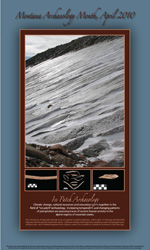Introduction
In the past few decades rare and unique organic archeological and paleontological materials have been discovered in association with once permanent melting snow and ice in northwestern North America and elsewhere around the world. The appearance of these unique cultural and scientific resources is a direct result of global warming. The discoveries offer important new insights into alpine paleoecology and the use of high elevation environments by humans. They are exceedingly important to science and to the ancestors of the people who made them; they are an important part of our collective world heritage.
This webpage is designed to provide basic information and updates about the evolving field of ice patch archaeology.
Dr. Ryan - Archaeology and Climate Change from Dr. Ryan on Vimeo.
Film by Earth Initiatives
Contact: info (at) earth-initiatives.org
What is an ice patch?
Ice patches are permanent snow and ice fields that survive the summer months as a result of drifted windblown snow. They are not massive enough to become glaciers, although snow in these locations can eventually turn into ice through the process of nivation.
Why are they important?
Some ice patches were used prehistorically for a variety of purposes, including hunting game animals, e.g., big horn sheep, bison and caribou, attracted to the locations. Many of the preserved organic artifacts that result from encounters between humans and animals at these locations include arrows, darts, sinew lashing and fletching; however, non-hunting artifacts, including basketry, clothing, and cordage have also been recovered.
What should you do if you find something on
or near an ice patch?
Nearly all of the permanent snow and ice in North America occurs on land under the jurisdiction of the federal government or Native American tribes. Consequently, all of the cultural and paleontological artifacts and specimens associated with these unique features are protected by legislation, including the Archeological Resources Protection Act (ARPA), the American Antiquities Act, as well as numerous other statues and regulations.
The appropriate legal and ethical course of action requires that you:
- 1) Do not take or collect the artifact or specimen(s)
- 2) Mark the location(s) on a map and/or with a GPS device;
- 3) Document the discovery with numerous photos showing the object and an overview of the area;
- 4) Report the find as soon as possible to an appropriate archaeologist - this invariably includes the resource manager for the land, e.g., USDA Forest Service or National Park Service (see contacts page)
Once exposed to the sun, wind and rain, previously arrested process of decay resume and artifacts and specimens can quickly deteriorate. Your discovery will be assessed by the archaeologist responsible for managing cultural resources on that particular section of land. Depending on the nature of the discovery it might be recovered and stabilized by the archaeologist, catalogued and analyzed. In general, you will be kept appraised of the results of the analysis and what is happening with the discovery. In due course the discovery may be taken to an accredited artifact repository where it will be accessible to other researchers and available on loan for museums and other educational purposes.
Acknowledgements:
University of Colorado – Institute of Arctic and Alpine Research; USDA Forest Service – Custer, Gallatin and Shoshone National Forests and the Remote Sensing Applications Center; Buffalo Bill Historical Center - Cody Institute for Western American Studies;
National Park Service – Denali National Park, Rocky Mountain National Park, Yellowstone National Park, and the Rocky Mountain Cooperative Ecosystem Studies Unit
